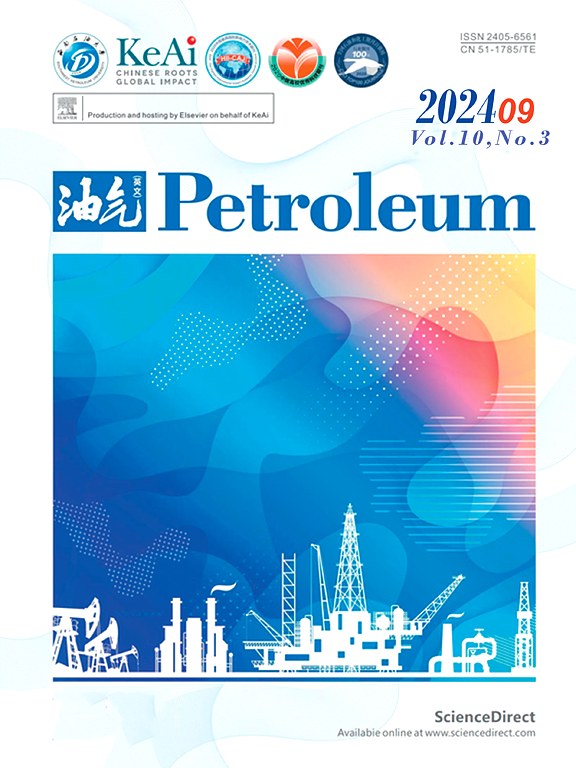Synergistic enhancement of oil recovery: Integrating anionic-nonionic surfactant mixtures, SiO2 nanoparticles, and polymer solutions for optimized crude oil extraction
IF 3.5
Q2 ENERGY & FUELS
引用次数: 0
Abstract
Enhanced oil recovery (EOR) methods are essential for optimizing oil extraction from modern reservoirs. This research delved into the synergistic impact of combining anionic and nonionic surfactant mixtures with silica (SiO2) nanoparticles (NPs) in sodium chloride (NaCl) solutions, alongside the added enhancement of polymers, to improve crude oil recovery. The study comprehensively evaluated stability, rheological characteristics, interfacial tension (IFT) behavior, wettability alterations, and EOR experiments using mixtures of sodium dodecyl sulfate (SDS) and triton X-100 (TX-100) surfactants. Scenarios both with and without SiO2 NPs in a base solution containing 3000 ppm NaCl and 2000 ppm xanthan gum (XG) polymer were examined. Core flooding tests were carried out on San-Saba sandstone core specimens with low permeability. The stability tests and dynamic light scattering (DLS) analysis were performed to assess the stability of NPs in low saline-surfactant-polymer solution. It was observed that NPs significantly reduced the IFT between the test solutions and crude oil, with nanofluids exhibiting satisfactory stability at a 0.4 wt% SiO2 NPs concentration. Core flooding studies demonstrated a synergistic interaction between NPs and the binary surfactant-polymer mixture, resulting in substantially greater incremental recovery of oil in comparison with the case of using binary surfactant-polymer combination alone. The mechanisms contributing to EOR with nanofluids, such as IFT reduction and wettability alteration, were explored. Incorporating NPs at concentrations of 0.1, 0.2, and 0.4 wt% led to incremental oil recoveries of 4.01%, 12.35%, and 12.73% of the original oil in place (OOIP), respectively, as opposed to the recovery achieved using only SDS + TX-100 + XG. Consequently, these findings advance the understanding of the potential application of SiO2 NPs in combination with the binary surfactant-polymer mixture as effective chemical EOR agents. Additionally, these insights aid in identifying suitable sandstone reservoirs for nanofluid application, contributing to the optimization of oil recovery strategies.
协同提高原油采收率:结合阴离子-非离子表面活性剂混合物、SiO2纳米颗粒和聚合物溶液,优化原油采收率
提高采收率(EOR)方法是优化现代油藏采油的关键。该研究深入研究了在氯化钠溶液中,阴离子和非离子表面活性剂混合物与二氧化硅纳米颗粒(NPs)的协同作用,以及聚合物的增强作用,以提高原油采收率。该研究综合评估了十二烷基硫酸钠(SDS)和triton X-100 (TX-100)表面活性剂混合物的稳定性、流变性、界面张力(IFT)行为、润湿性变化以及EOR实验。在含有3000 ppm NaCl和2000 ppm黄原胶(XG)聚合物的基础溶液中,研究了含SiO2 NPs和不含SiO2 NPs的情况。对San-Saba低渗透砂岩岩心进行了岩心驱替试验。通过稳定性测试和动态光散射(DLS)分析来评估NPs在低盐表面活性剂-聚合物溶液中的稳定性。NPs显著降低了测试溶液与原油之间的IFT,纳米流体在SiO2 NPs浓度为0.4 wt%时表现出令人满意的稳定性。岩心驱油研究表明,NPs与二元表面活性剂-聚合物混合物之间存在协同作用,与单独使用二元表面活性剂-聚合物混合物的情况相比,其产油量增量要大得多。探讨了纳米流体提高EOR的机理,如降低IFT和改变润湿性。加入浓度为0.1、0.2和0.4 wt%的NPs后,原油采收率分别为原始油藏(OOIP)的4.01%、12.35%和12.73%,而仅使用SDS + TX-100 + XG的采收率则不同。因此,这些发现促进了人们对二氧化硅纳米颗粒与二元表面活性剂-聚合物混合物作为有效的化学提高采收率剂的潜在应用的理解。此外,这些见解有助于确定适合纳米流体应用的砂岩储层,有助于优化采油策略。
本文章由计算机程序翻译,如有差异,请以英文原文为准。
求助全文
约1分钟内获得全文
求助全文
来源期刊

Petroleum
Earth and Planetary Sciences-Geology
CiteScore
9.20
自引率
0.00%
发文量
76
审稿时长
124 days
期刊介绍:
Examples of appropriate topical areas that will be considered include the following: 1.comprehensive research on oil and gas reservoir (reservoir geology): -geological basis of oil and gas reservoirs -reservoir geochemistry -reservoir formation mechanism -reservoir identification methods and techniques 2.kinetics of oil and gas basins and analyses of potential oil and gas resources: -fine description factors of hydrocarbon accumulation -mechanism analysis on recovery and dynamic accumulation process -relationship between accumulation factors and the accumulation process -analysis of oil and gas potential resource 3.theories and methods for complex reservoir geophysical prospecting: -geophysical basis of deep geologic structures and background of hydrocarbon occurrence -geophysical prediction of deep and complex reservoirs -physical test analyses and numerical simulations of reservoir rocks -anisotropic medium seismic imaging theory and new technology for multiwave seismic exploration -o theories and methods for reservoir fluid geophysical identification and prediction 4.theories, methods, technology, and design for complex reservoir development: -reservoir percolation theory and application technology -field development theories and methods -theory and technology for enhancing recovery efficiency 5.working liquid for oil and gas wells and reservoir protection technology: -working chemicals and mechanics for oil and gas wells -reservoir protection technology 6.new techniques and technologies for oil and gas drilling and production: -under-balanced drilling/gas drilling -special-track well drilling -cementing and completion of oil and gas wells -engineering safety applications for oil and gas wells -new technology of fracture acidizing
 求助内容:
求助内容: 应助结果提醒方式:
应助结果提醒方式:


